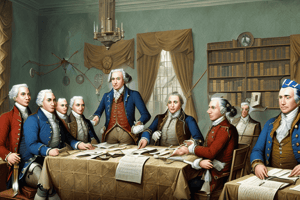Podcast
Questions and Answers
What were the main weaknesses of the Articles of Confederation?
What were the main weaknesses of the Articles of Confederation?
The main weaknesses included the lack of an executive branch, inability to levy taxes, and the requirement for unanimous state consent to pass legislation.
What was the primary goal of the Constitutional Convention held in 1787?
What was the primary goal of the Constitutional Convention held in 1787?
The primary goal was to revise the Articles of Confederation, but the delegates ended up creating a new Constitution.
Describe the Great Compromise and its significance.
Describe the Great Compromise and its significance.
The Great Compromise established a bicameral legislature with representation based on population in the House and equal representation in the Senate, balancing the interests of both large and small states.
What was the Three-Fifths Compromise, and what issue did it address?
What was the Three-Fifths Compromise, and what issue did it address?
What are the Bill of Rights, and why were they added to the Constitution?
What are the Bill of Rights, and why were they added to the Constitution?
Who were the Federalists, and what was their main argument?
Who were the Federalists, and what was their main argument?
What concerns did Anti-Federalists have regarding the new Constitution?
What concerns did Anti-Federalists have regarding the new Constitution?
How many states were required to ratify the Constitution?
How many states were required to ratify the Constitution?
What role did public opinion play in the ratification process of the Constitution?
What role did public opinion play in the ratification process of the Constitution?
What impact did the promised Bill of Rights have on the Constitution's ratification?
What impact did the promised Bill of Rights have on the Constitution's ratification?
Flashcards
Articles of Confederation
Articles of Confederation
The first attempt at an American government, consisting of a weak central government with limited powers and a focus on states' rights. It lacked an executive branch, a president, and a judiciary, leading to ineffectiveness.
Constitutional Convention
Constitutional Convention
A group of delegates from different states gathered in Philadelphia in 1787 to address the weaknesses of the Articles of Confederation. They ultimately drafted the United States Constitution, which established a stronger federal government.
Great Compromise
Great Compromise
This compromise addressed the debate between large and small states regarding representation in the legislature. It created a bicameral Congress with a House of Representatives (population-based) and a Senate (equal representation per state).
Three-Fifths Compromise
Three-Fifths Compromise
Signup and view all the flashcards
Bill of Rights
Bill of Rights
Signup and view all the flashcards
Federalists
Federalists
Signup and view all the flashcards
Anti-Federalists
Anti-Federalists
Signup and view all the flashcards
Ratification of the Constitution
Ratification of the Constitution
Signup and view all the flashcards
Amending the Constitution
Amending the Constitution
Signup and view all the flashcards
Checks and Balances
Checks and Balances
Signup and view all the flashcards
Study Notes
The Articles of Confederation
- The Articles of Confederation was the first attempt at an American government, failing to effectively govern due to significant weaknesses.
- It lacked an executive branch, a president, and a judiciary to resolve disputes, leading to a weak central authority.
- It was primarily a congress with equal state representation, allowing individual states to veto unfavorable legislation, hindering national unity.
- The Articles government couldn't levy taxes, relying on state contributions, often denied, severely limiting its financial stability and operation.
The Constitutional Convention
- Delegates from various states convened in Philadelphia in 1787 to revise the Articles of Confederation.
- The convention ultimately abandoned the Articles and, instead, drafted a new constitution, reflecting a decision to create a stronger national government.
- Delegates from different states presented various agendas and debated the structure of the new government, often with conflicting priorities.
- Compromise was crucial in reaching agreement on the Constitution to form a unified nation.
Key Compromises in the Constitution
- The Great Compromise: Proposed by Roger Sherman, it established a bicameral legislature with a House of Representatives, representation proportional to population, satisfying larger states, and a Senate, equal representation for each state, thus appeasing smaller states.
- The Three-Fifths Compromise: Determined that each enslaved person would count as three-fifths of a free person for purposes of representation, favoring states with larger enslaved populations.
- The Bill of Rights: A set of ten amendments added to the Constitution to safeguard fundamental rights and liberties, responding to Anti-Federalist concerns about potential government overreach.
Key Players and Groups
- Federalists: Supporters of the Constitution, advocating for a strong central government, crucial for national unity. They championed the Constitution and presented their viewpoints through collected writings called "The Federalist Papers."
- Anti-Federalists: Opponents of the Constitution, advocating for a weaker central government and greater state autonomy, emphasizing individual rights and freedoms. They voiced concerns about potential abuses of power by the federal government.
Ratification of the Constitution
- The Constitution required ratification by at least nine out of thirteen states.
- Public opinion was divided, with Federalists and Anti-Federalists presenting opposing arguments.
- The ratification process played a fundamental role in shaping the Constitution through public discourse and debate.
- The promised Bill of Rights was vital in securing ratification by allaying Anti-Federalist fears about an overreaching central authority.
Importance of Compromise
- Compromise has been pivotal in the American system of governance, shaping the Constitution and facilitating consensus among diverse groups.
- The Constitution is itself a testament to compromise, illustrating its role in achieving agreement among conflicting interests.
- The balancing of diverse interests and the willingness to concede are crucial components of a healthy democratic process.
Studying That Suits You
Use AI to generate personalized quizzes and flashcards to suit your learning preferences.




